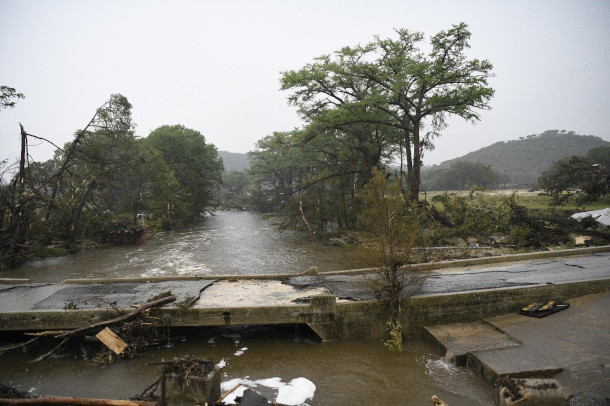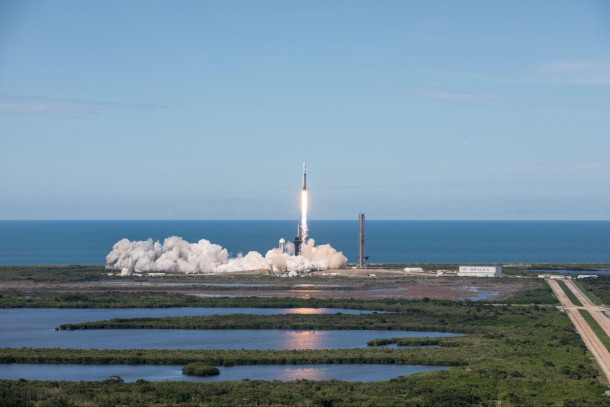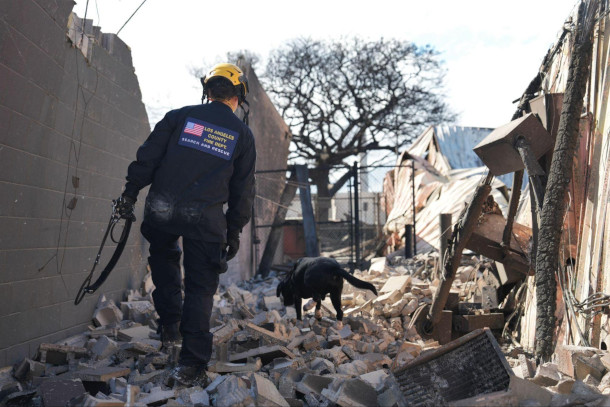Weakening Disaster Prep
Air Date: Week of July 18, 2025

Devastation from the July 4, 2025 floods in Central Texas. (Photo: World Central Kitchen, Wikimedia Commons, CC BY 4.0)
Weather forecasting, climate research and climate resilience are being hit with major budget and staffing cuts by the Trump administration. Alice Hill is a senior fellow at the Council on Foreign Relations who served on the National Security Council under President Obama, and she joins Host Jenni Doering to discuss how recent federal cuts can impact emergency preparedness for floods such as the one that devastated the Texas hill country.
Transcript
O’NEILL: From PRX and the Jennifer and Ted Stanley Studios at the University of Massachusetts, Boston, this is Living on Earth. I’m Aynsley O’Neill.
DOERING: And I’m Jenni Doering.
Weather forecasting, climate research, and climate resilience are being hit with major budget and staffing cuts by the Trump administration. And this all comes at a time when the US is experiencing extreme rainfall supercharged by a hotter atmosphere that can hold much more moisture. Recent flash floods have devastated parts of Texas and wreaked havoc in states across the Northeast, New Mexico, and North Carolina. Joining us now to discuss how recent federal cuts can impact emergency preparedness is Alice Hill, a Senior Fellow for Energy and the Environment at the Council on Foreign Relations. She also served as the Senior Director for Resilience Policy on the National Security Council and as a Special Assistant to President Obama. Welcome to Living on Earth, Alice!
HILL: Well, thank you for having me.
DOERING: So I understand that there are a number of Trump administration cuts to disaster preparedness and climate resiliency that have already taken place. Can you walk us through some of those?
HILL: The Trump administration has taken steps that will curtail emergency preparedness and actually reduce the capacity of the United States to respond to disasters. The most immediate of those things that have already occurred is that staff cuts took place, and those took place through the DOGE process under Elon Musk's leadership. Many senior members of FEMA, the Federal Emergency and Management Administration, took the buyout offer and left, and that meant that senior administrators were unavailable going forward to help with future disaster recovery as well as planning and preparedness. There have also been steps to reduce training offered by FEMA. FEMA has historically, in recent years, trained emergency managers from across the states, and the reason why that's so important is that you want emergency managers in one county to be able to easily communicate with members of Emergency Management from an adjoining county or a nearby county. We know that these disasters do not honor our jurisdictional boundaries. They cross borders. So you need to have the personnel that's responsible for taking care of a disaster be able to communicate easily, and FEMA stepped into that to provide training. It also provides grant funding to help communities prepare themselves and as well as reduce the risk going forward, and the Trump administration has terminated one of the most important programs for building resilience that's called the Building Resilient Infrastructure and Communities program.
DOERING: And why was that program so important?

The National Oceanic and Atmospheric Administration, NOAA, conducts climate research through weather-observing and environmental monitoring satellites like NOAA’s GOES-U satellite, pictured above during its launch. (Photo: Kevin O'Connell & Kevin Davies, NASA, Flickr, Public Domain)
HILL: That program, it's known as BRIC, really presented a sea change in terms of the amount of money that the federal government invested in disaster risk reduction. Now studies have shown, one of them from the National Institute of Building Sciences, another from the US Chamber of Commerce, have shown that for every dollar invested in risk reduction, there's a huge payoff. It can be up to $13 according to the Chamber of Commerce. FEMA and the, this NIBs study, the National Institute of Building Sciences, estimates that investment, for example, in stronger building codes will save $11 in damages for every dollar invested. So this BRIC program took about 6% of what the nation spends, up to 6% of what the nation spends on disasters, and put that to reducing risk in advance, pre-disaster risk reduction. It covered things like moving homes away from flood areas, better building in wildfire zones to make homes more fire resistant, protecting wastewater treatment plants. The program was wildly popular. Ironically, it was started under President Trump during his first administration, but in April, FEMA and the Trump administration terminated all the grants that were outstanding, and have said this will not go forward. This has been devastating to communities who are counting on federal money to help them get better prepared, and the program has already given close to $5 billion in grants in the short time that it's been in place.
DOERING: So those are some of the cuts to FEMA that have been happening under this second Trump administration. What about cuts to the National Oceanic and Atmospheric Administration, or NOAA, which does a lot of weather and climate science? How are those cuts impacting climate resiliency and disaster preparedness across the US?
HILL: Well, NOAA is widely viewed as the premier meteorological service in the world. Other countries depend on NOAA's work in determining what are the changes to the weather, to the climate that are occurring currently, and what we should learn and understand about those changes in terms of how we can better protect people and property. The cuts, similar to FEMA, first were to staff, so there have been a lot of staff reduced at NOAA and reports of, for example, meteorologists being let go, and the meteorologists are key to creating weather predictions, weather forecasts, and those weather forecasts then in turn inform early warnings, and early warnings in turn allow people to take action before disaster strikes, to reduce harm, save lives and take care of their property. These cuts to staff have meant that forecasts are at risk for accuracy and the ability to have full input from the collection of data to make sure that they're the most robust forecasts that they can be. And of course, if you don't have a robust forecast, you could be very surprised by an event, and that will cause more damage.

FEMA Urban Search and Rescue teams work alongside the National Guard, as well as local fire departments in the Hawaii Wildfires. Shown here, the Los Angeles County Fire Department sent their rescue team to aid in operations. (Photo: Dominick Del Vecchio, FEMA, Wikimedia Commons, Public Domain)
DOERING: When a disaster hits, obviously it's a horrible thing, but what's the usual protocol? Like, who is the first to act? You know, states or the federal government?
HILL: Well, the first to act is the local community, and then the states. And then, under our system, FEMA is called in when the state and local territorial tribal governments are overwhelmed. That's when you call the cavalry, and FEMA is the cavalry. So the plan is that if a state is overwhelmed by a catastrophe or a local government, local government turns the state, and then the state can turn to FEMA and call in help to handle something that's really beyond the capabilities that they would normally have. So you can think of a small, localized flood the state and local leaders would respond to that, but if it's massive flooding, then they're going to need FEMA to help them, because they'll need capabilities like search and rescue teams. They'll need additional food, water, housing for people displaced by the disasters and they may in a wildfire, need help with firefighting teams from other jurisdictions to come in, and FEMA can assist with that if the state doesn't have those relationships pre-existing to do this on their own.
DOERING: The fiscal year 2026q5u federal budget that the Trump administration has proposed is still just a proposal at this point, but I understand that it includes a number of significant cuts to disaster preparedness and climate resiliency. For example, 10 NOAA labs would be closed, including one that develops accurate flash flood forecasts. How would these proposed cuts change the way the federal government helps communities better prepare for climate disasters?
HILL: Well, the proposed cuts, particularly to NOAA, would really undermine our ability to understand how the climate is changing, and what we see repeatedly is that a terrible event will occur. Media will be deployed, and they'll come out and interview victims, and the victims will say, I've never seen anything like this before, even though I've lived here 40, 50, whatever amount of years. Well, with climate change, we will see many more events that are bigger than anyone has experienced in human history. So the work that NOAA was doing through those 10 laboratories and other programs was designed to help us better understand how big can those events get? How are they unfolding, and what can we do to protect ourselves from them? So the shutdown of those laboratories, and that climate science research fundamentally kneecaps the ability of the United States to understand what is occurring and what is ahead, and that means we will be less prepared.
View on Threads
DOERING: Now the Trump administration has also disbanded the 400 scientists involved in the National Climate Assessment. Why is that significant? And in the past, how has that assessment helped communities across the US face climate disruption?
HILL: The Trump administration is cutting information to states and communities regarding their risk. The National Climate Assessment, that's a congressionally mandated report. It comes out about every four years, and I served on an advisory committee for the Third National Climate Assessment. The purpose of that assessment is to inform Americans about the nature of climate risk in the United States. It tells them, by region, what kind of risks they can expect. For example, in northeast, we're experiencing flooding in Vermont, that report will tell you, in the northeast, we'll see very extreme flooding. In the Western United States, we're seeing drought and wildfires. That report would also detail how that is unfolding and how it's anticipated to unfold in the future. I also covers critical infrastructure. So what's happening to water availability? In drought areas you're not going to have a strong water access. What's happening to wastewater treatment when areas flood? Often wastewater treatment is for obvious reasons, at the bottom of the hill, and it gets flooded out and we need to protect those facilities so that they can continue to operate even in heightened flood conditions. So that program, the National Climate Assessment, is on pause. The 400 volunteer scientists who were contributing to that report have been told the program is dismantled, and then we have removed from public websites information about climate risk. That means that communities are flying blind. If they don't have the money that a New York or California has to hire private consultants, they are at great risk of underestimating what's going to happen, and therefore not making adequate preparations.
DOERING: Right and, you know, I imagine that decisions such as whether to rebuild after a flood or, you know, after a wildfire, just not understanding those risks and the likelihood that those kinds of things are going to maybe keep happening could really be dangerous for communities.
With Trump’s exit from the #Paris #climate agreement, all countries—including the US—should amp #adaptation efforts. “Drill, baby, drill” =“Fry, baby, fry.”As CA’s #wildfires have revealed we don’t know how to adapt to the heat that’s already here—much less what’s ahead www.cnn.com/2025/01/20/c...
— Alice C. Hill (@alice-c-hill.bsky.social) January 20, 2025 at 5:30 PM
[image or embed]
HILL: Absolutely, that is exactly the kind of information in that crisis moment everyone wants to rebuild, but it would be helpful to know, and firefighters will tell you, if it's burned once, it's likely to burn again, or if that last flood you thought was big, you can expect even larger floods in the future unless there's increased flood protections put in place. you're absolutely right That's the kind of information communities desperately need to make better informed, more fiscally sound decisions. Decisions that also save lives.
DOERING: Alice Hill is a Senior Fellow for Energy and the Environment at the Council on Foreign Relations, who also served on the National Security Council under President Obama. Thank you so much, Alice.
HILL: Thank you. What a pleasure.
[MUSIC: Chet Baker, “All Blues – 2024 Remastered Version” on Round Midnight 79 (2024 Remastered Version), Diggers Factory]
O’NEILL: Climate disasters are taking a toll on national treasures including the iconic Grand Canyon Lodge, destroyed in recent days by a wildfire. Next week we plan to cover the Trump administration cuts to the National Park Service, and we had the chance to ask our guest, public historian Donna Graves, about the impact of this fire. Here’s a taste.
GRAVES: In a place like Grand Canyon, a fire destroys cultural resources, but obviously the landscape itself, and that landscape is so meaningful to traditional people who have lived there for a millennium and to the millions of visitors from across the United States and around the world who come to see this iconic landscape that represents our nation. To not be able to protect those, which I'm concerned, about both because the administration is defunding Park research on climate change, but also because this administration seems to be wanting to defund preparedness in response to climate change disasters, I fear that so many of the places we love are going to suffer that same fate that the Grand Canyon did.
O’NEILL: Tune in next week to hear that and more.
Links
Yale Climate Connections | “Cuts to NOAA Increase the Risk of Deadly Weather Tragedies”
The Guardian | "Trump administration sued by 20 states for cutting disaster prevention grants"
Living on Earth wants to hear from you!
Living on Earth
62 Calef Highway, Suite 212
Lee, NH 03861
Telephone: 617-287-4121
E-mail: comments@loe.org
Newsletter [Click here]
Donate to Living on Earth!
Living on Earth is an independent media program and relies entirely on contributions from listeners and institutions supporting public service. Please donate now to preserve an independent environmental voice.
NewsletterLiving on Earth offers a weekly delivery of the show's rundown to your mailbox. Sign up for our newsletter today!
 Sailors For The Sea: Be the change you want to sea.
Sailors For The Sea: Be the change you want to sea.
 The Grantham Foundation for the Protection of the Environment: Committed to protecting and improving the health of the global environment.
The Grantham Foundation for the Protection of the Environment: Committed to protecting and improving the health of the global environment.
 Contribute to Living on Earth and receive, as our gift to you, an archival print of one of Mark Seth Lender's extraordinary wildlife photographs. Follow the link to see Mark's current collection of photographs.
Contribute to Living on Earth and receive, as our gift to you, an archival print of one of Mark Seth Lender's extraordinary wildlife photographs. Follow the link to see Mark's current collection of photographs.
 Buy a signed copy of Mark Seth Lender's book Smeagull the Seagull & support Living on Earth
Buy a signed copy of Mark Seth Lender's book Smeagull the Seagull & support Living on Earth

